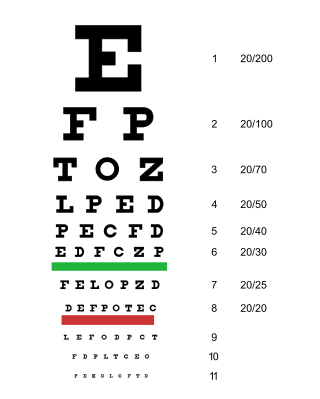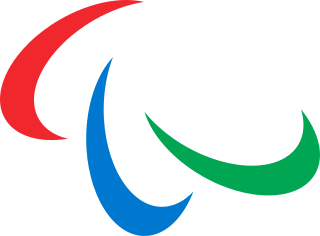
Visual acuity (VA) commonly refers to the clarity of vision, but technically rates an animal's ability to recognize small details with precision. Visual acuity depends on optical and neural factors. Optical factors of the eye influence the sharpness of an image on its retina. Neural factors include the health and functioning of the retina, of the neural pathways to the brain, and of the interpretative faculty of the brain.

A Snellen chart is an eye chart that can be used to measure visual acuity. Snellen charts are named after the Dutch ophthalmologist Herman Snellen who developed the chart in 1862 as a measurement tool for the acuity formula developed by his professor Franciscus Cornelius Donders. Many ophthalmologists and vision scientists now use an improved chart known as the LogMAR chart.

The Summer Paralympics, also known as the Games of the Paralympiad, are an international multi-sport event where athletes with physical disabilities compete. This includes athletes with mobility disabilities, amputations, blindness, and cerebral palsy. The Paralympic Games are held every four years, organized by the International Paralympic Committee. Medals are awarded in every event, with gold medals for first place, silver for second and bronze for third, a tradition that the Olympic Games started in 1904.

B1 is a medical-based Paralympic classification for blind sport. Athletes in this classification are totally or almost totally blind. It is used by a number of blind sports including blind tennis, blind cricket, blind golf, five-a-side football, goalball and judo. Some other sports, including adaptive rowing, athletics and swimming, have equivalents to this class. It was used by para-alpine skiing and para-Nordic skiing until 2024.

B2 is a medical based Paralympic classification for blind sport. Competitors in this classification have vision that falls between the B1 and B3 classes. The International Blind Sports Federation (IBSA) defines this classification as "visual acuity ranging from LogMAR 1.50 to 2.60 (inclusive) and/or visual field constricted to a diameter of less than 10 degrees." It is used by a number of blind sports including para-alpine skiing, para-Nordic skiing, blind cricket, blind golf, five-a-side football, goalball and judo. Some sports, including adaptive rowing, athletics and swimming, have equivalents to this class.

B3 is a medical based Paralympic classification for blind sport. Competitors in this classification have partial sight, with visual acuity from 2/60 to 6/60. It is used by a number of blind sports including para-alpine skiing, para-Nordic skiing, blind cricket, blind golf, five-a-side football, goalball and judo. Some other sports, including adaptive rowing, athletics and swimming, have equivalents to this class.
Goalball classification is the classification system for goalball. Goalball players with a disability are classified into different categories based on their vision based disability type. The classification is handled by the International Blind Sports Association.
Paratriathlon classification is the classification system for athletes participating in paratriathlon. It is governed by the World Triathlon. The sport has been included in the 2016 Summer Paralympics.
Disability judo classification is the medical classification system for disability judo. Judokas with a disability are classified into different categories based on their disability type. The classification is handled by the Blind Sports Association.
Para judo is an adaptation of the Japanese martial art of judo for visually impaired competitors. The rules of the sport are only slightly different from regular judo competitions. It has been part of the Summer Paralympics program since 1988 for men and 2004 for women.
B4 is a blind sport classification used in a variety of sports including sailing, bowls, swimming, and cycling. Unlike other blind sport classes, it only uses visual acuity for the purpose of being classed into it.
The Men's +90 kg J1 judo competition at the 2024 Summer Paralympics was held in September 2024 at the Champ-de-Mars Arena, Paris.
The men's 60 kg J1 judo competition at the 2024 Summer Paralympics was held on 5 September 2024 at the Champ de Mars.
The Men's 90 kg J1 judo competition at the 2024 Summer Paralympics was held in September 2024 at the Champ-de-Mars Arena, Paris.
The women's 48 kg J1 judo competition at the 2024 Summer Paralympics was held on 5 September 2024 at the Champ-de-Mars Arena, Paris.
The women's 100 metres T12 event at the 2024 Summer Paralympics in Paris, took place between 4 and 5 September 2024.
The Men's 400 metres T12 at the 2024 Summer Paralympics took place on 4-5 September 2024 at the Stade de France in Paris.
The Men's 400 metres T13 at the 2024 Summer Paralympics took place on 5 September 2024 at the Stade de France in Paris.

The men's marathon T12 event at the 2024 Summer Paralympics in Paris, took place on 8 September 2024.

The women's marathon T12 event at the 2024 Summer Paralympics in Paris, took place on 8 September 2024.







